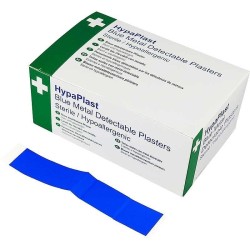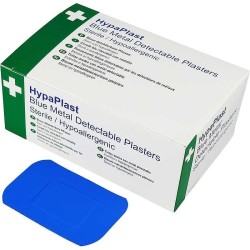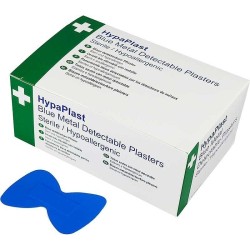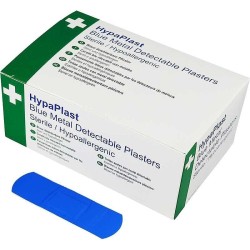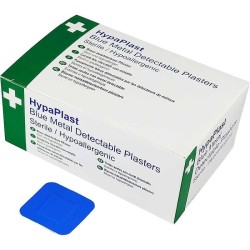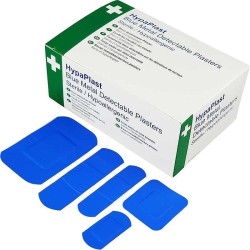First Aid Blue Metal Plasters
There are 6 products.
Active filters
About First Aid Blue Metal Plasters
Detectable Wound Protection for Food Industry Compliance
First aid blue metal detectable plasters provide specialist wound protection incorporating metal strips enabling detection by metal detectors, serving food manufacturing, catering, and food handling environments throughout England, Scotland, Wales, and Northern Ireland. These essential food industry products combine highly visible blue colouring with embedded metal strips, ensuring lost plasters can be detected before products reach consumers, supporting HACCP compliance and food safety. Food industry organisations rely on blue metal detectable plasters for food handler wound protection meeting regulatory requirements, foreign object prevention through detectability, visual identification through distinctive blue colouring, HACCP compliance demonstration, and comprehensive food safety management. Modern blue metal detectable plasters incorporate features including embedded metal strips detectable by standard metal detectors, bright blue colouring easily visible against food products, strong adhesion maintaining position during food handling, waterproof properties withstanding hand washing, and varied sizes accommodating different wounds. The provision of blue metal detectable plasters demonstrates commitment to food safety, supports regulatory compliance, enables professional food industry wound management, and fulfils essential HACCP requirements across food production and handling environments throughout professional food industry contexts.
The implementation of blue metal detectable plasters directly supports food safety, regulatory compliance, and demonstration of professional food industry hygiene management. Food industry regulations require measures preventing foreign object contamination, with appropriate wound covering and detectability essential. Blue metal detectable plasters address these requirements by enabling metal detector identification if plasters are lost, providing visual detectability through distinctive blue colouring absent from food products, supporting regulatory compliance particularly HACCP requirements, demonstrating professional food safety management, and preventing contamination incidents. Food industry applications include food manufacturing worker wound care, catering environment hygiene compliance, food handling wound protection, HACCP-compliant first aid provision, and food safety system integration. Food industry organisations benefit from blue metal detectable plasters through regulatory compliance, prevented contamination incidents avoiding product recalls and reputation damage, demonstrated professional food safety commitment, and comprehensive HACCP system support. Modern blue metal detectable plasters incorporate features such as enhanced metal content ensuring reliable detection and superior adhesion throughout England, Scotland, Wales, and Northern Ireland.
Selecting and implementing blue metal detectable plasters requires food safety risk assessment, appropriate specification, and integration with HACCP systems across food industry organisations throughout the UK. Food safety and technical managers should evaluate wound protection requirements within food handling areas, assess metal detector capabilities ensuring plaster detectability, review HACCP plans incorporating plaster protocols, and calculate adequate stock levels. Product selection should prioritise reliable metal detectability confirmed through metal detector testing, distinctive blue colouring providing visual identification, strong waterproof adhesion withstanding food industry conditions, varied sizes, and adequate quantities ensuring exclusive use in food handling areas. Implementation protocols must encompass strict policies requiring only blue metal detectable plasters in food handling areas, staff training on appropriate use including immediate replacement if lost, integration with HACCP procedures documenting plaster use and loss incidents, clear signage identifying authorised plasters, and documented supply management. Quality assurance measures should include regular metal detector testing verifying plaster detectability, periodic audits ensuring compliance, usage monitoring, incident recording and investigation when plasters are lost, and HACCP verification. Modern blue metal detectable plaster management integrates with food safety management systems. Organisations must establish rigorous protocols including designated plaster locations, lost plaster procedures requiring production stops and area checks, documentation for HACCP verification, and regular metal detector validation. Staff education must emphasise food safety importance, exclusive use of blue metal detectable plasters in food areas, immediate reporting if plasters are lost, and hand hygiene protocols. Storage must separate blue metal detectable stocks from standard plasters preventing accidental use of non-detectable types in food areas. By implementing blue metal detectable plasters alongside professional food safety protocols, food industry organisations throughout England, Scotland, Wales, and Northern Ireland demonstrate commitment to regulatory compliance, HACCP requirements, foreign object contamination prevention, and professional food safety management supporting consumer protection and product integrity across all food production and handling environments.

